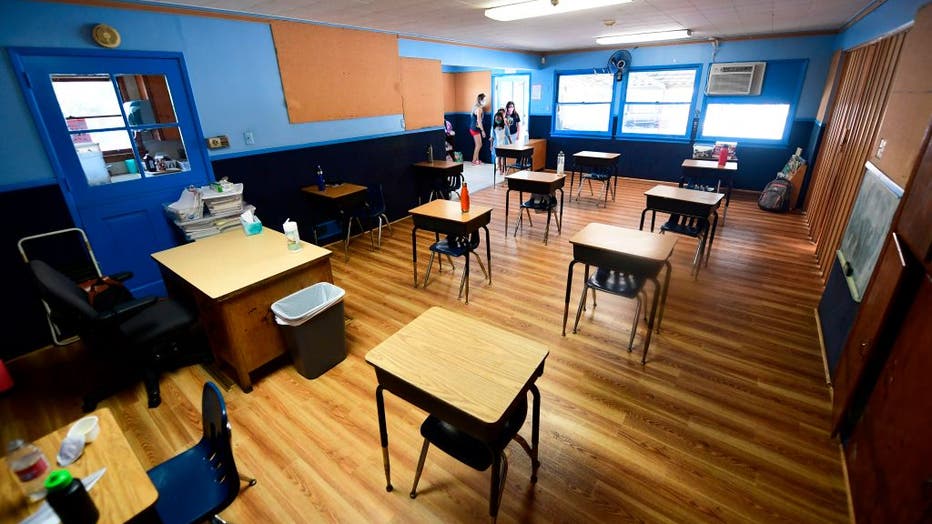CDC releases updated guidelines calling the reopening of schools 'critically important'
WASHINGTON - The Centers for Disease Control and Prevention on Thursday released updated guidelines on schools amid the coronavirus pandemic, emphasizing the importance of reopening classrooms.
The updated guidance urged school leaders to work with local officials to make decisions about the fall, taking into account the virus's rate of transmission in the area. It laid out a range of measures depending on the level of spread.
If there's minimal or moderate spread, it recommends social distancing, masks and increased sanitation. In areas with substantive and uncontrolled spread, school closure is an “important consideration.”
“Plans for virtual learning should be in place in the event of a school closure,” the CDC said.

Children in an elementary school class wearing masks enter the classroom with desks spaced apart as per coronavirus guidelines during summer school sessions in Monterey Park, California on July 9, 2020. (Photo by FREDERIC J. BROWN/AFP via Getty Image
RELATED: CoronavirusNOW.com, FOX launches national hub for COVID-19 news and updates
The CDC said “the best available evidence indicates” that COVID-19 poses a relatively low risk to school-aged children, and that kids appear to be at a lower risk for becoming infected with the virus compared to adults.
The agency noted that as of July 17, children and adolescents account for under 7% of COVID-19 cases in the U.S. — and less than 0.1% of virus-related deaths. There have been more than 4 million confirmed cases in the U.S. as of July 24, according to data compiled by Johns Hopkins University.
“It is critically important for our public health to open schools this fall,” said CDC Director Dr. Robert Redfield in a statement. “School closures have disrupted normal ways of life for children and parents, and they have had negative health consequences on our youth. CDC is prepared to work with K-12 schools to safely reopen while protecting the most vulnerable.”
For schools with zero to minimal spread, the CDC’s recommendations include reinforcing everyday preventive actions, ensuring proper ventilation within school facilities, including buses, and maintaining cleaning and disinfection practices.
If there is minimal to moderate spread, schools should also work to ensure that student and staff groupings “are as static as possible” and that mixing groups of students and staff is limited to lower the risk of tramsission.
“Schools should be prepared for COVID-19 cases and exposure to occur in their facilities. Collaborating with local health officials will continue to be important once students are back to school,” the guidelines read in part.
The updated guidance comes as the Trump administration has pushed in recent weeks for schools to fully reopen in the fall. Contrary to the CDC statement, some health experts have argued that evidence behind what role children play in the coronavirus pandemic and how it affects them remains unclear.
RELATED: How does COVID-19 affect kids? Science has answers and gaps
Many have also noted the risk for teachers and other school staff. Three Arizona summer school teachers who followed the CDC guidelines while in the same classroom recently contracted the virus, and one of them died.
In a notable shift on Thursday while speaking at a White House news conference, Trump said districts in some virus hot spots “may need to delay reopening for a few weeks.” Even as he tempered his position, Trump insisted that every school should be “actively making preparations to open.”
RELATED: ‘It’s not the right time’: Trump calls off Florida segment of GOP National Convention
Some of the nation's largest districts have already rejected the idea of a full reopening. The Los Angeles and San Diego districts plan to keep classes online this fall, while New York City's schools plan to offer a mix of online and in-person instruction.
Education Secretary Betsy DeVos has said that students should be in the classroom every day if their families want and that any alternative fails students and taxpayers.
RELATED: LAUSD students won't be returning for in-person classes this fall
In many states, education leaders have said they want to return to school but lack the funding to implement safety measures. A group of state education chiefs has said U.S. schools would need more than $200 billion to prepare for a fall reopening.
On Thursday, Trump said he's asking Congress to provide $105 billion in education funding as part of the next virus relief bill — intended to help schools reduce class sizes, hire teachers, rearrange spaces and provide masks.
But if a local district doesn't open, Trump said the money should be steered to parents so they can pursue other education options.
"If schools do not reopen, the funding should go to parents to send their children to the public, private, charter, religious or home school,” he said. “All families should be empowered to make the decision that is right for their circumstance.”
This story was reported from Cincinnati. The Associated Press contributed.



